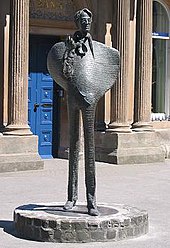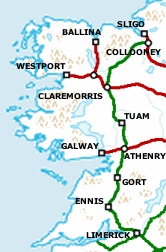Sligo
[6] The Ordnance Survey letters of 1836 state that "cart loads of shells were found underground in many places within the town where houses now stand".The area around Sligo town has one of the highest densities of prehistoric archaeological sites in Ireland, and is the only place in which all classes of Irish megalithic monuments are to be found together.[9] Danagher's work also documented a Bronze Age Henge at Tonafortes (beside the Carraroe roundabout) on the southern outskirts of Sligo town.Sligo Bay is an ancient natural harbour, being known to Greek, Phoenician and Roman traders as the area is thought by some to be the location marked as the city of Nagnata on Claudius Ptolemy's second century A.D. co-ordinate map of the world.[10] During the early medieval period, the site of Sligo was eclipsed by the importance of the great monastery founded by Columcille 5 miles to the north at Drumcliff.The annalists refer to the town as a sraidbhaile ('street settlement') which seems to have consisted of the castle and an attached defensive bawn in the vicinity of Quay street.A Dominican Friary (Blackfriars) was also founded by Maurice Fitzgerald and the King of Connacht, Felim mac Cathal Crobderg Ua Conchobair, in 1253.The Norman advance was halted in Sligo after the battle of Credran Cille in 1257 at Ros Ceite (Rosses Point) between Godfrey O'Donnell, Lord of Tirconnell, and Maurice Fitzgerald.Through competition between Gaelic dynasties for the lucrative port duties of Sligo, the town was burned, sacked or besieged approximately 49 times during the medieval period, according to the annals of Ireland.Patrick Sarsfield was able to capture the town and repulsed a Williamite attack to retake it; however, Sligo was later surrendered to forces under the command of Arthur Forbes, 1st Earl of Granard.After fleeing to Ballyshannon, Charlotte wrote: At the end of that time, we were able to live in peace till the plague had abated and we could return to Sligo.Be sure answer this by return of post.The early years of the century saw much industrial unrest as workers in the Port of Sligo fought for better pay and conditions.The Border Region in the Republic of Ireland has a population of over 500,000 people and consists of the counties of Cavan, Donegal, Leitrim, Louth and Monaghan.[22] The former Batchelors factory on Deep Water Quay is an industrial building which was built in 1905 as a maize mill and grain silo, and used an innovative construction method invented by François Hennebique in 1892.[30] The Indian Malankara Orthodox Syrian Church meets at the St. Johns Hospital Chapel, Benbullen Rehabilitation Unit, Ballytivan.[clarification needed] The pharmaceutical industry is significant with several companies producing goods for this sector,[34] including Abbott (Ireland) Ltd, which is among the largest employers in Sligo.[40] In the early 13th century, the poet and crusader Muireadhach Albanach Ó Dálaigh kept a school of poetry at Lissadell north of Sligo town.In the 16th century, the poet Tadhg Dall Ó hÚigínn wrote many praise poems in strict Dán Díreach metre for local chiefs and patrons such as the O'Conor Sligo.[citation needed] In the 17th century, two brothers from County Sligo, Thomas and William Connellan from Cloonamahon, were among the last of the great Irish bards and harpists.Thomas is the author of the tune Molly MacAlpin, now known as Carolan's Dream, and William may have written Love is a Tormenting Pain and Killiecrankie.Traditional musicians from Sligo active in the early 20th century include Michael Coleman, James Morrison and Paddy Killoran.visited Sligo, even during the Dublin season, showing that in those days the townsfolk appreciated the Drama, for in some instances the company remained during several months".Sligo is the setting for John Michael McDonagh's 2014 darkly comedic drama film Calvary,[44] in which a priest continues to serve his parishioners despite their increased hostility towards him and the Catholic Church.Many of the major Gaelic football and hurling matches, such as the inter-county home games of Sligo or a club championship finals, take place at Markievicz Park.Rosses Point hosted the West of Ireland Championship in which future golfing star Rory McIlroy won in consecutive years (2005 and 2006).Sligo was administered by its own local oireachtas and the kings of Cáirbre Drom Cliab until the English conquest in the early 17th century.St. Angela's College (outside the town proper) is a campus of the Atlantic Technological University, and offers courses in nursing and health studies, home economics and education.Sligo has a certain amount of cycleways in proximity to the town and various road traffic calming measures have been installed helping to improve safety for pedestrians and cyclists.The most northerly base in Ireland, it deals with the stern challenges posed by the Atlantic Ocean and the clifftop environment along the north-west coast.[67][better source needed] In modern times, the port handles cargoes of coal, timber, fish meal and scrap metal and around 25 ships per year dock in the harbour.










Sligo (disambiguation)Sligo Town HallProvinceConnachtCountyCounty SligoBaronyCarburyDáil constituencySligo–LeitrimEU ParliamentMidlands–North-WestEircodeseaportcounty town24th largest in the Republic of IrelandIrelandW. B. YeatsHistory of Sligoshellfishshell middensGaravogueThe Destruction of Da Dergas HostelAnnals of UlsterOrdnance SurveyBallysadareMesolithicprehistorypassage tombCarrowmoreCúil Iorra Peninsulaarchaeological sitesKnocknareaMiosgan MaeveNational Roads AuthorityNeolithiccausewayed enclosureMagheraboy causewayed enclosurepalisadeBronze AgeSligo BayPhoenicianNagnataClaudius PtolemymonasteryColumcilleDrumcliffNormanMaurice FitzgeraldJusticiar of IrelandSligo CastleannalistsDominicanFelim mac Cathal Crobderg Ua ConchobairCredran CilleRosses PointTirconnellburgessesO'Conchobar SligighKings of ConnachttúathCairbre Drom CliabhTír Fhíacrach MúaidheLuighne ConnachtTir OlliolCorannFénechusBristolSir Nicholas MalbySligo AbbeySir Frederick Hamilton'sWilliamite WarJacobiteIrish ArmyJames IIWilliamitePatrick SarsfieldArthur Forbes, 1st Earl of GranardEssex Fenciblesbattle of CarricknagatCollooneyGeneral HumbertBartholomew Teeling1798 Rebellioncholera outbreakBram StokerCharlotte Blake ThornleyBallyshannonDraculaGaravogue RiverGreat FamineSligo dock strikeBritish ArmyWar of IndependenceSligo GaolLiam PilkingtonArthur GriffithSt. John the Baptist's ChurchDiocese of Kilmore, Elphin and ArdaghLough GillBenbulbenUlsterRoman Catholic Diocese of ElphinBorder Regionthe BorderDonegalLeitrimMonaghanBurgageSligo Holy Cross Dominican FriaryRichard CasselsHazelwood HouseLombardo-RomanesqueSligo CourthouseRawson CarrollTemperanceModel Arts & Niland GalleryFrançois HennebiqueClimate of Irelandtemperate oceanictemperate rainforestMarkree Castle2022 censusLapsed (Roman) CatholicIslamicChurch of Ireland